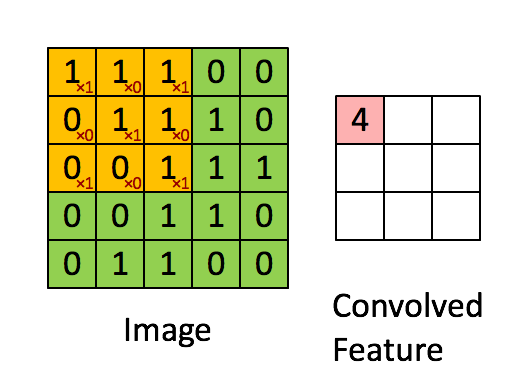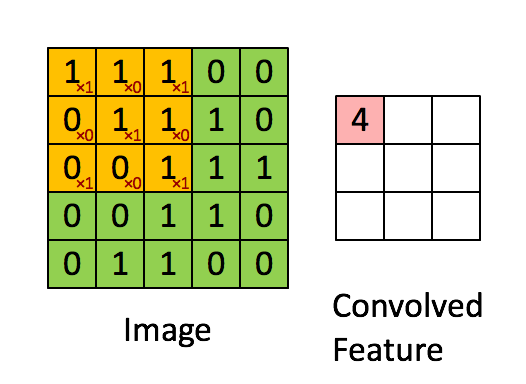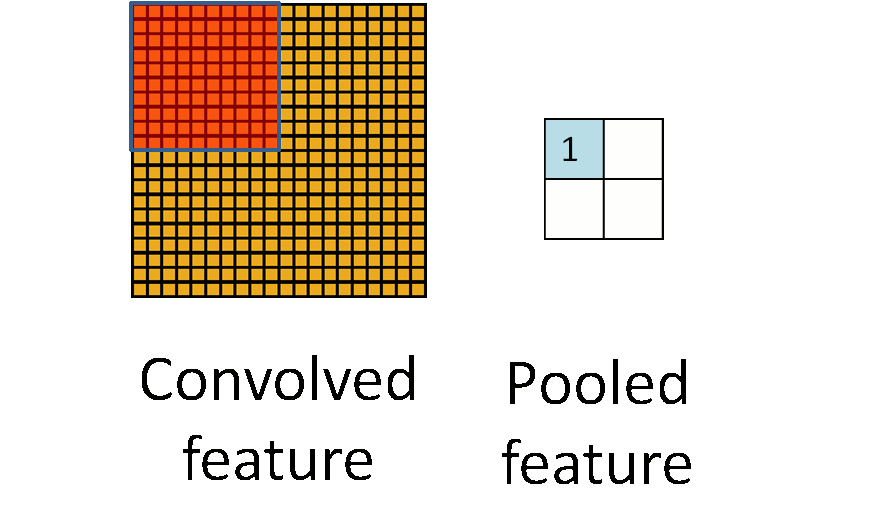TensorFlow.NET机器学习入门【7】采用卷积神经网络(CNN)处理Fashion-MNIST
本文将介绍如何采用卷积神经网络(CNN)来处理Fashion-MNIST数据集。
程序流程如下:
1、准备样本数据
2、构建卷积神经网络模型
3、网络学习(训练)
4、消费、测试
除了网络模型的构建,其它步骤都和前面介绍的普通神经网络的处理完全一致,本文就不重复介绍了,重点讲一下模型的构建。
先看代码:
/// <summary>
/// 构建网络模型
/// </summary>
private Model BuildModel()
{
// 网络参数
float scale = 1.0f / 255; var model = keras.Sequential(new List<ILayer>
{
keras.layers.Rescaling(scale, input_shape: (img_rows, img_cols, channel)), keras.layers.Conv2D(32, 5, padding: "same", activation: keras.activations.Relu),
keras.layers.MaxPooling2D(), keras.layers.Conv2D(64, 3, padding: "same", activation: keras.activations.Relu),
keras.layers.MaxPooling2D(), keras.layers.Flatten(),
keras.layers.Dense(128, activation: keras.activations.Relu),
keras.layers.Dense(num_classes,activation:keras.activations.Softmax)
}); return model;
}
keras.layers.Conv2D方法创建一个卷积层
keras.layers.MaxPooling2D方法创建一个池化层
卷积层的含义:

如上图所示,原始数据尺寸为5*5,卷积核大小为3*3,当卷积核滑过原始图片时,卷积核和图片对应的数据进行运算(先乘后加),并形成新的数据。
示例的卷积核为[[1,0,1],[0,1,0],[1,0,1]],和左上角数据卷积后结果为4,填写到对应位置。对整改图片全部滑动一遍,即形成最终结果。

采用卷积神经网络,相对于前面介绍的普通神经网络有什么优势呢?
1、首先,图像本身是一个二维数据,普通网络首先要把数据拉平,这一点就不合理,而卷积网络通过卷积核处理数据,保留了原始数据的基本特征;
2、其次,采用卷积网络大大减小了参数的数量。假设原始图片分辨率为100*100,拉平后长度为10000,后面跟一个全连接层,输出为128,此时参数量为(10000+1)*128,超过128万。这才一个全连接层。如果采用CNN,参数数量取决于卷积核的大小和数量。假设卷积核大小为5*5,数量为32,此时参数数量为:(5*5+1)*32=832。【计算方法下面会详细介绍】
池化层的含义:
池化就是压缩,就是图片数据太大了,通过池化把分辨率减小一些。

池化有均值池化和最大值池化方法,这个很好理解,就是一推数据中取平均值或最大值。MaxPooling2D明显是最大池化法。
我们再看一下这个代码:
keras.layers.Conv2D(32, 5, padding: "same", activation: keras.activations.Relu),
32表示卷积核数量为32,卷积核大小为5*5,padding: "same"表示对图像进行边缘补零,不然卷积后的图像尺寸会变小,补零后图像尺寸不变。
整体模型摘要信息如下:

下面逐行解释一下:
1、首先输入层的数据Shape为:(28,28,1),28表示图片像素,1表示灰度图片,如果是彩色图片,应该为(28,28,3)
2、Rescaling对数据进行处理,统一乘以一个系数,这里没有需要训练的参数
3、引入一个卷积层,卷积核数量为32,卷积核大小为5*5(图上看不出来),此时参数数量为:(5*5+1)*32=832,这里卷积核尺寸为5*5,所以有25个参数,这很好理解,+1是因为作为卷积计算后还要加一个偏置b,所以每个卷积核共26个参数。由于有32个卷积核,要对同一个图像采用不同的卷积核做32次计算,所以这一层输出数据为(28,28,32)
4、池化层将数据从(28,28,32)压缩到(14,14,32)
5、再引入一个卷积层,卷积核数量为64,卷积核大小为3*3(图上看不出来),这次计算和第一次不太一样:由于上一层数据共有32片,对每一片数据采用的卷积核是不一样的,所以这里实际一共有32*9=288个卷积核。首先用32个卷积核和上述32片数据分别进行卷积形成32片数据,然后将32片数据叠加求和,最后再加一个偏置形成一片新数据,重复进行64次,形成64片新数据。此时参数数量为:(288+1)*64=18496
【注意:这里的算法其实是和第一层卷积算法完全一样的,只是第一层输入为灰度图片,数据只有一片,如果输入为彩色图片,就一致了。】
6、池化层将数据从(14,14,64)压缩到(7,7,64)
7、将数据拉平,拉平后的数据长度为:7*7*64=3136
8、引入全连接层,输出神经元数量为128,此时参数数量为:(3136+1)*128=401536
9、最后为全连接层输出,输出神经元数量为10,参数数量为:(128+1)*10=1290
现在,由于参数数量已经很多了,训练需要的时间也比较长了,所以需要把训练完成后的参数保存下来,下次可以重新加载保存的参数接着训练,不用从头再来。
保存的模型也可以发布到生产系统用于实际的消费。
全部代码如下:


/// <summary>
/// 采用卷积神经网络处理Fashion-MNIST数据集
/// </summary>
public class CNN_Fashion_MNIST
{
private readonly string TrainImagePath = @"D:\Study\Blogs\TF_Net\Asset\fashion_mnist_png\train";
private readonly string TestImagePath = @"D:\Study\Blogs\TF_Net\Asset\fashion_mnist_png\test";
private readonly string train_date_path = @"D:\Study\Blogs\TF_Net\Asset\fashion_mnist_png\cnn_train_data.bin";
private readonly string train_label_path = @"D:\Study\Blogs\TF_Net\Asset\fashion_mnist_png\cnn_train_label.bin";
private readonly string ModelFile = @"D:\Study\Blogs\TF_Net\Model\cnn_fashion_mnist.h5"; private readonly int img_rows = 28;
private readonly int img_cols = 28;
private readonly int channel = 1;
private readonly int num_classes = 10; // total classes public void Run()
{
var model = BuildModel();
model.summary();
model.load_weights(ModelFile); Console.WriteLine("press any key");
Console.ReadKey(); model.compile(optimizer: keras.optimizers.Adam(0.0001f),
loss: keras.losses.SparseCategoricalCrossentropy(),
metrics: new[] { "accuracy" }); (NDArray train_x, NDArray train_y) = LoadTrainingData();
model.fit(train_x, train_y, batch_size: 512, epochs: 1);
model.save_weights(ModelFile); test(model);
} /// <summary>
/// 构建网络模型
/// </summary>
private Model BuildModel()
{
// 网络参数
float scale = 1.0f / 255; var model = keras.Sequential(new List<ILayer>
{
keras.layers.Rescaling(scale, input_shape: (img_rows, img_cols, channel)), keras.layers.Conv2D(32, 5, padding: "same", activation: keras.activations.Relu),
keras.layers.MaxPooling2D(), keras.layers.Conv2D(64, 3, padding: "same", activation: keras.activations.Relu),
keras.layers.MaxPooling2D(), keras.layers.Flatten(),
keras.layers.Dense(128, activation: keras.activations.Relu),
keras.layers.Dense(num_classes,activation:keras.activations.Softmax)
}); return model;
} /// <summary>
/// 加载训练数据
/// </summary>
/// <param name="total_size"></param>
private (NDArray, NDArray) LoadTrainingData()
{
try
{
Console.WriteLine("Load data");
IFormatter serializer = new BinaryFormatter();
FileStream loadFile = new FileStream(train_date_path, FileMode.Open, FileAccess.Read);
float[,,,] arrx = serializer.Deserialize(loadFile) as float[,,,]; loadFile = new FileStream(train_label_path, FileMode.Open, FileAccess.Read);
int[] arry = serializer.Deserialize(loadFile) as int[];
Console.WriteLine("Load data success");
return (np.array(arrx), np.array(arry));
}
catch (Exception ex)
{
Console.WriteLine($"Load data Exception:{ex.Message}");
return LoadRawData();
}
} private (NDArray, NDArray) LoadRawData()
{
Console.WriteLine("LoadRawData"); int total_size = 60000;
float[,,,] arrx = new float[total_size, img_rows, img_cols, channel];
int[] arry = new int[total_size]; int count = 0; DirectoryInfo RootDir = new DirectoryInfo(TrainImagePath);
foreach (var Dir in RootDir.GetDirectories())
{
foreach (var file in Dir.GetFiles("*.png"))
{
Bitmap bmp = (Bitmap)Image.FromFile(file.FullName);
if (bmp.Width != img_cols || bmp.Height != img_rows)
{
continue;
} for (int row = 0; row < img_rows; row++)
for (int col = 0; col < img_cols; col++)
{
var pixel = bmp.GetPixel(col, row);
int val = (pixel.R + pixel.G + pixel.B) / 3; arrx[count, row, col, 0] = val;
arry[count] = int.Parse(Dir.Name);
} count++;
} Console.WriteLine($"Load image data count={count}");
} Console.WriteLine("LoadRawData finished");
//Save Data
Console.WriteLine("Save data");
IFormatter serializer = new BinaryFormatter(); //开始序列化
FileStream saveFile = new FileStream(train_date_path, FileMode.Create, FileAccess.Write);
serializer.Serialize(saveFile, arrx);
saveFile.Close(); saveFile = new FileStream(train_label_path, FileMode.Create, FileAccess.Write);
serializer.Serialize(saveFile, arry);
saveFile.Close();
Console.WriteLine("Save data finished"); return (np.array(arrx), np.array(arry));
} /// <summary>
/// 消费模型
/// </summary>
private void test(Model model)
{
Random rand = new Random(1); DirectoryInfo TestDir = new DirectoryInfo(TestImagePath);
foreach (var ChildDir in TestDir.GetDirectories())
{
Console.WriteLine($"Folder:【{ChildDir.Name}】");
var Files = ChildDir.GetFiles("*.png");
for (int i = 0; i < 10; i++)
{
int index = rand.Next(1000);
var image = Files[index]; var x = LoadImage(image.FullName);
var pred_y = model.Apply(x);
var result = argmax(pred_y[0].numpy()); Console.WriteLine($"FileName:{image.Name}\tPred:{result}");
}
}
} private NDArray LoadImage(string filename)
{
float[,,,] arrx = new float[1, img_rows, img_cols, channel];
Bitmap bmp = (Bitmap)Image.FromFile(filename); for (int row = 0; row < img_rows; row++)
for (int col = 0; col < img_cols; col++)
{
var pixel = bmp.GetPixel(col, row);
int val = (pixel.R + pixel.G + pixel.B) / 3;
arrx[0, row, col, 0] = val;
} return np.array(arrx);
} private int argmax(NDArray array)
{
var arr = array.reshape(-1); float max = 0;
for (int i = 0; i < 10; i++)
{
if (arr[i] > max)
{
max = arr[i];
}
} for (int i = 0; i < 10; i++)
{
if (arr[i] == max)
{
return i;
}
} return 0;
}
}
通过采用CNN的方法,我们可以把Fashion-MNIST识别率提高到大约94%左右,而且还有提高的空间。但是网络的优化是一件非常困难的事情,特别是识别率已经很高的时候,想提高1个百分点都是很不容易的。
以下是一个优化过的网络,我查阅了不少资料,也参考了很多代码,才构建了这个网络,它的识别率约为96%,再怎么调整也提高不上去了。
/// <summary>
/// 构建网络模型
/// </summary>
private Model BuildModel()
{
// 网络参数
float scale = 1.0f / 255;
var model = keras.Sequential(new List<ILayer>
{
keras.layers.Rescaling(scale, input_shape: (img_rows, img_cols, channel)), keras.layers.Conv2D(32, 3, padding: "same", activation: keras.activations.Relu),
keras.layers.MaxPooling2D(), keras.layers.Conv2D(64, 3, padding: "same", activation: keras.activations.Relu),
keras.layers.MaxPooling2D(), keras.layers.Dropout(0.3f),
keras.layers.BatchNormalization(), keras.layers.Conv2D(128, 3, padding: "same", activation: keras.activations.Relu),
keras.layers.Conv2D(128, 3, padding: "same", activation: keras.activations.Relu),
keras.layers.MaxPooling2D(), keras.layers.Dropout(0.4f),
keras.layers.Flatten(),
keras.layers.Dense(512, activation: keras.activations.Relu),
keras.layers.Dropout(0.25f),
keras.layers.Dense(num_classes,activation:keras.activations.Softmax)
}); return model;
}
【参考资料】
卷积神经网络CNN总结 - Madcola - 博客园 (cnblogs.com)
卷积神经网络(CNN)模型结构 - 刘建平Pinard - 博客园 (cnblogs.com)
【相关资源】
源码:Git: https://gitee.com/seabluescn/tf_not.git
项目名称:CNN_Fashion_MNIST,CNN_Fashion_MNIST_Plus
TensorFlow.NET机器学习入门【7】采用卷积神经网络(CNN)处理Fashion-MNIST的更多相关文章
- 深度学习:Keras入门(二)之卷积神经网络(CNN)
说明:这篇文章需要有一些相关的基础知识,否则看起来可能比较吃力. 1.卷积与神经元 1.1 什么是卷积? 简单来说,卷积(或内积)就是一种先把对应位置相乘然后再把结果相加的运算.(具体含义或者数学公式 ...
- 深度学习:Keras入门(二)之卷积神经网络(CNN)【转】
本文转载自:https://www.cnblogs.com/lc1217/p/7324935.html 说明:这篇文章需要有一些相关的基础知识,否则看起来可能比较吃力. 1.卷积与神经元 1.1 什么 ...
- 深度学习:Keras入门(二)之卷积神经网络(CNN)(转)
转自http://www.cnblogs.com/lc1217/p/7324935.html 1.卷积与神经元 1.1 什么是卷积? 简单来说,卷积(或内积)就是一种先把对应位置相乘然后再把结果相加的 ...
- TensorFlow实战第八课(卷积神经网络CNN)
首先我们来简单的了解一下什么是卷积神经网路(Convolutional Neural Network) 卷积神经网络是近些年逐步兴起的一种人工神经网络结构, 因为利用卷积神经网络在图像和语音识别方面能 ...
- 使用卷积神经网络CNN训练识别mnist
算的的上是自己搭建的第一个卷积神经网络.网络结构比较简单. 输入为单通道的mnist数据集.它是一张28*28,包含784个特征值的图片 我们第一层输入,使用5*5的卷积核进行卷积,输出32张特征图, ...
- 卷积神经网络(CNN)代码实现(MNIST)解析
在http://blog.csdn.net/fengbingchun/article/details/50814710中给出了CNN的简单实现,这里对每一步的实现作个说明: 共7层:依次为输入层.C1 ...
- 【深度学习系列】手写数字识别卷积神经--卷积神经网络CNN原理详解(一)
上篇文章我们给出了用paddlepaddle来做手写数字识别的示例,并对网络结构进行到了调整,提高了识别的精度.有的同学表示不是很理解原理,为什么传统的机器学习算法,简单的神经网络(如多层感知机)都可 ...
- 【深度学习系列】卷积神经网络CNN原理详解(一)——基本原理
上篇文章我们给出了用paddlepaddle来做手写数字识别的示例,并对网络结构进行到了调整,提高了识别的精度.有的同学表示不是很理解原理,为什么传统的机器学习算法,简单的神经网络(如多层感知机)都可 ...
- TensorFlow.NET机器学习入门【6】采用神经网络处理Fashion-MNIST
"如果一个算法在MNIST上不work,那么它就根本没法用:而如果它在MNIST上work,它在其他数据上也可能不work". -- 马克吐温 上一篇文章我们实现了一个MNIST手 ...
随机推荐
- HTML5 之 FileReader 的使用 (网页上图片拖拽并且预显示可在这里学到) [转载]
转载至 : http://www.360doc.com/content/14/0214/18/1457948_352511416.shtml FileReader 资料(英文) : https://d ...
- 容器之分类与各种测试(三)——slist的用法
slist和forward_list的不同之处在于其所在的库 使用slist需要包含 #include<ext\list> 而使用forward_list则需要包含 #include< ...
- AFNetworking 网络错误提示data转换字符串
AFN在进行网络交互时,有时候会碰到返回502.500.404的时候.后台的总需要你配合他查出问题所在.但是AFN在返回数据序列化时解析错误只会转成NSData类型的数据,如果直接扔给后台Data的数 ...
- 【Linux】【Shell】【Basic】条件测试和变量
bash脚本编程 脚本文件格式: 第一行,顶格:#!/bin/bash 注释信息:# 代码注释: 缩进,适度添加空白行: ...
- html标签设置contenteditable时,去除粘贴文本自带样式
在一个div标签里面加了可编辑的属性,从别的地方复制了一串文本,只想把文本内容存到接口里面,结果发现文本自带的标签和样式都会存进去. $(".session-new-name"). ...
- 在html页面通过绝对地址显示图片
1.编辑tomcat中conf目录下的server.xml文件,在<Host></Host>中添加如下代码段 <Context path="/D" d ...
- ANTLR 简介
<ANTLR 4权威指南>由机械工业出版社出版,有兴趣的读者推荐购买阅读. 本专题大多内容来源于我读<ANTLR 4权威指南>的随手笔记以及个人实践,仅供参考学习,请勿用于任何 ...
- SQLserver 2014自定义备份数据库
一.管理-维护计划-维护计划向导-下一步 二.点击更改设置任务执行时间-确定-下一步 三.选择备份数据库完整-下一步 四.选择需要备份的数据库-然后确定 五.点目标自定义备份文件存储目录-下一步 六. ...
- 设置项目的开始/完成日期(Project)
<Project2016 企业项目管理实践>张会斌 董方好 编著 在设定完日程排定方法,或者不作任何设置,依其默认的[项目开始日期]的设置,接下来就要设置项目的开始时间了.依然是在[项目] ...
- textarea控件好奇怪啊,用<s:if>标签居然不在一行回出现很多的空格,奇葩啊
textarea控件好奇怪啊,用<s:if>标签居然不在一行回出现很多的空格,奇葩啊
